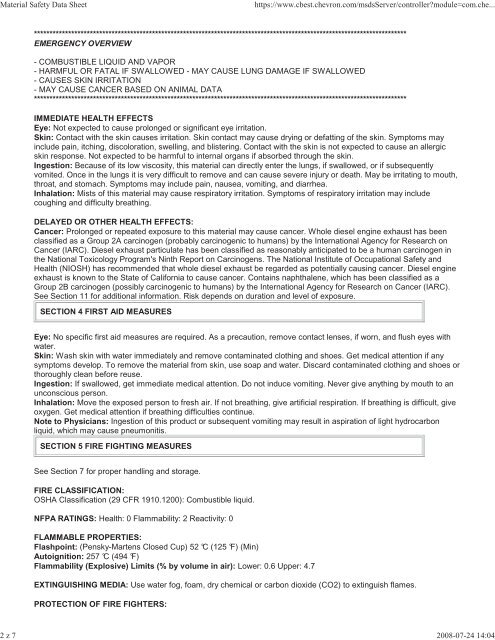Print MSDS - Miller Electric Company Publications
Print MSDS - Miller Electric Company Publications
Print MSDS - Miller Electric Company Publications
Create successful ePaper yourself
Turn your PDF publications into a flip-book with our unique Google optimized e-Paper software.
Material Safety Data Sheet https://www.cbest.chevron.com/msdsServer/controller?module=com.che...<br />
************************************************************************************************************************<br />
EMERGENCY OVERVIEW<br />
- COMBUSTIBLE LIQUID AND VAPOR<br />
- HARMFUL OR FATAL IF SWALLOWED - MAY CAUSE LUNG DAMAGE IF SWALLOWED<br />
- CAUSES SKIN IRRITATION<br />
- MAY CAUSE CANCER BASED ON ANIMAL DATA<br />
************************************************************************************************************************<br />
IMMEDIATE HEALTH EFFECTS<br />
Eye: Not expected to cause prolonged or significant eye irritation.<br />
Skin: Contact with the skin causes irritation. Skin contact may cause drying or defatting of the skin. Symptoms may<br />
include pain, itching, discoloration, swelling, and blistering. Contact with the skin is not expected to cause an allergic<br />
skin response. Not expected to be harmful to internal organs if absorbed through the skin.<br />
Ingestion: Because of its low viscosity, this material can directly enter the lungs, if swallowed, or if subsequently<br />
vomited. Once in the lungs it is very difficult to remove and can cause severe injury or death. May be irritating to mouth,<br />
throat, and stomach. Symptoms may include pain, nausea, vomiting, and diarrhea.<br />
Inhalation: Mists of this material may cause respiratory irritation. Symptoms of respiratory irritation may include<br />
coughing and difficulty breathing.<br />
DELAYED OR OTHER HEALTH EFFECTS:<br />
Cancer: Prolonged or repeated exposure to this material may cause cancer. Whole diesel engine exhaust has been<br />
classified as a Group 2A carcinogen (probably carcinogenic to humans) by the International Agency for Research on<br />
Cancer (IARC). Diesel exhaust particulate has been classified as reasonably anticipated to be a human carcinogen in<br />
the National Toxicology Program's Ninth Report on Carcinogens. The National Institute of Occupational Safety and<br />
Health (NIOSH) has recommended that whole diesel exhaust be regarded as potentially causing cancer. Diesel engine<br />
exhaust is known to the State of California to cause cancer. Contains naphthalene, which has been classified as a<br />
Group 2B carcinogen (possibly carcinogenic to humans) by the International Agency for Research on Cancer (IARC).<br />
See Section 11 for additional information. Risk depends on duration and level of exposure.<br />
SECTION 4 FIRST AID MEASURES<br />
Eye: No specific first aid measures are required. As a precaution, remove contact lenses, if worn, and flush eyes with<br />
water.<br />
Skin: Wash skin with water immediately and remove contaminated clothing and shoes. Get medical attention if any<br />
symptoms develop. To remove the material from skin, use soap and water. Discard contaminated clothing and shoes or<br />
thoroughly clean before reuse.<br />
Ingestion: If swallowed, get immediate medical attention. Do not induce vomiting. Never give anything by mouth to an<br />
unconscious person.<br />
Inhalation: Move the exposed person to fresh air. If not breathing, give artificial respiration. If breathing is difficult, give<br />
oxygen. Get medical attention if breathing difficulties continue.<br />
Note to Physicians: Ingestion of this product or subsequent vomiting may result in aspiration of light hydrocarbon<br />
liquid, which may cause pneumonitis.<br />
SECTION 5 FIRE FIGHTING MEASURES<br />
See Section 7 for proper handling and storage.<br />
FIRE CLASSIFICATION:<br />
OSHA Classification (29 CFR 1910.1200): Combustible liquid.<br />
NFPA RATINGS: Health: 0 Flammability: 2 Reactivity: 0<br />
FLAMMABLE PROPERTIES:<br />
Flashpoint: (Pensky-Martens Closed Cup) 52 °C (125 °F) (Min)<br />
Autoignition: 257 °C (494 °F)<br />
Flammability (Explosive) Limits (% by volume in air): Lower: 0.6 Upper: 4.7<br />
EXTINGUISHING MEDIA: Use water fog, foam, dry chemical or carbon dioxide (CO2) to extinguish flames.<br />
PROTECTION OF FIRE FIGHTERS:<br />
2 z 7 2008-07-24 14:04



